ACE 2006: Microeconomics of
Supply
Economical Simplification of a single Business or Firm of any
sort - the logic of competitive supply: The following is an
explanation of the
implications of competitive survival of firms, NOT a
management prescription of how to manage such firms.
What happens to total costs as
production levels increase, ceteris paribus?
The ONLY things which we are changing in this analysis are the level of
output (production) of the firm (and thus the level of inputs and
resources
that are needed to produce more output). The costs of the inputs
per unit are held fixed and constant. The technology available is
fixed. The quality and productivity of the inputs are given and
known, and unchanging.
The quality of the product is fixed.
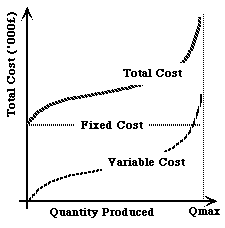 Summary:
Fixed
costs are those costs (including all relevant opportunity costs)
which do not vary as the quantity produced varies. Variable
costs
are those costs which do vary as production quantities change (increase
as output is increased). Total costs equal fixed
costs plus variable costs. The general shape will look
pretty
much like this, for any production process we care to think of.
Summary:
Fixed
costs are those costs (including all relevant opportunity costs)
which do not vary as the quantity produced varies. Variable
costs
are those costs which do vary as production quantities change (increase
as output is increased). Total costs equal fixed
costs plus variable costs. The general shape will look
pretty
much like this, for any production process we care to think of.
- Fixed Costs - sometimes considered to be equivalent to the costs
of the factors
of production: land, labour, management and capital plant and
equipment etc. - the resources needed to be in production at all.
- Variable Costs - sometimes considered to be equivalent to the
costs of
the purchased inputs (fuel, raw materials, packaging materials
etc.) No one can produce something for nothing - variable cost,
and total cost, will always
increase as we increase production, supply, delivery - though may
increase only a very little over some part of the business's output or
throughput possibility range
- However, the distinction between fixed and variable costs depends
critically
on the particular and specifc conditions and circumstances of the firm
in question. The precise details of these specific (and highly
differentiated)
conditions do not need to concern us here. The general principles
still apply, whatever the precise fixed or variable
classification
of particular costs. The specific classification of costs is not
fundamentally important.
Unit Costs - costs per unit produced:
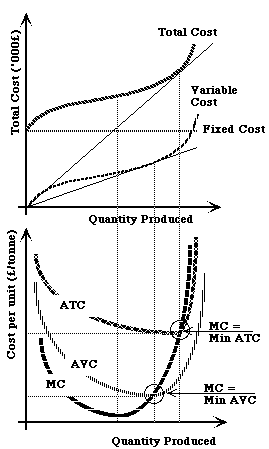 Summary
of Costs per unit produced:
Summary
of Costs per unit produced:
- Average Total Costs (total costs ÷ quantity
produced) is
shown by the slope of a line from the origin to any point on the
total cost
curve.
ATC is therefore "U" shaped, with a minimum where
the origin
line is tangential to the total cost curve.
- Average Variable Cost (AVC) is defined in exactly the
same
way (as
total variable costs ÷ quantity produced), and exhibits the same
"U" shape.
- Marginal cost (the cost of an extra or additional unit
of output)
is the slope of the total cost curve itself
- MC is at a minimum where the total cost curve is
flattest,
where its slope is least.
- For the quantity at which average cost is at a minimum,
average
cost
is equal to marginal cost. The marginal cost curve cuts the
average
cost curve from below, at the average cost curve's minimum point.
This has to be true by definition. Average cost at its minimum is
the slope of the tangent from the origin to the total cost cost
curve.
The tangent to the total cost curve has the same slope at that point as
the slope of the total cost curve, which is the marginal cost at that
point.
- These diagrams assume that the manager(s) of the firm are as
efficient
as they can be in making and implimenting the decisions to change
output
levels. They are effective in keeping costs as low as possible
consistent
with health, safety and product integrity. In short, they
assume
effective business managment and operation.
Maximising Profits - stylised illustration of the firms cost
curves:
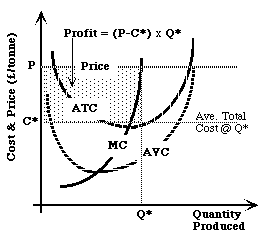 To
maximise
profits ( = total revenues minus total costs): produce at that
output
level at which
marginal cost equals marginal revenue. So long as
the MC curve is rising, this will mean that all previous units of
output
cost less to produce than they earn in revenue, and any greater level
of
output will cost more to produce than it earns in revenue.
To
maximise
profits ( = total revenues minus total costs): produce at that
output
level at which
marginal cost equals marginal revenue. So long as
the MC curve is rising, this will mean that all previous units of
output
cost less to produce than they earn in revenue, and any greater level
of
output will cost more to produce than it earns in revenue.
In a competitive industry (many other competing firms) the price
is set by the market - firms in a competitive market are
Price
Takers: there is no sense in charging less than the other firms,
because
this firm cannot produce enough to satisfy the whole market, and if it
trys to charge more, it loses sales to other competing firms.
In this competitive case, Price = Marginal Revenue (MR) (the
addition to total revenue consequent on the sale of one extra
unit).
Hence, profit maximisation involves producing at the quantity for which
MC
= MR = Price. If the market price is P, then the
profit
maximising output level is Q*, at which point MC = MR.
At this point, Average cost = C*, so that total cost = C* x Q*, while
total revenues = P x Q*. So, Profit = total revenues
minus
total costs = (P - C*)x Q* = the shaded area.
This profit is Pure (Economic) Profit - since the total costs include
all opportunity costs, the excess of revenues over total costs is pure
or economic profit over and above the returns necessary to cover all
costs. NOTICE - this Price = MC rule is the logical outcome of a
firm's competitive behaviour, NOT a prescription for the effective
management of the firm.
If this firm is making pure profit, then other firms will be
attracted
into this industry to produce this product. As they do, so total
market supply will increase, and the market price will fall (and, quite
probably, firm costs will increase as firms try and obtain more
resources and purchase more inputs, driving up the costs). When
will this competitive market be in equilibrium?
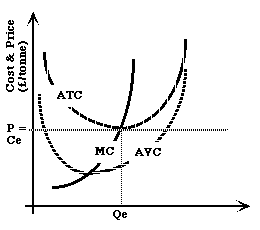 When
Price = MC = Min ATC (at Ce in this diagram) with no
pure
profits to encourage firms to expand or enter the industry, and
enough
to cover all costs, including opportunity costs. Each of the
firms
make just enough of a return to be willing to stay in the business
rather
than doing something else. The return that is just enough is the
return which covers all of the costs, cash costs and opportunity
costs.
The opportunity costs measure how much each firm could earn if it moved
its land, labour, capital and management into some other business or
occupation.
So long as each earns at least this return, each will be content to
stay
in this business indefinitely. If prices fall below this level,
firms
will leave the industry as the opportunity arises, and supplies will
fall,
and prices will start to rise again back to the equilibrium level.
When
Price = MC = Min ATC (at Ce in this diagram) with no
pure
profits to encourage firms to expand or enter the industry, and
enough
to cover all costs, including opportunity costs. Each of the
firms
make just enough of a return to be willing to stay in the business
rather
than doing something else. The return that is just enough is the
return which covers all of the costs, cash costs and opportunity
costs.
The opportunity costs measure how much each firm could earn if it moved
its land, labour, capital and management into some other business or
occupation.
So long as each earns at least this return, each will be content to
stay
in this business indefinitely. If prices fall below this level,
firms
will leave the industry as the opportunity arises, and supplies will
fall,
and prices will start to rise again back to the equilibrium level.
Industry Supply - depends on:
- each firms individual response to price changes
- the change in the number of firms in the industry (product
producing
sector)
- whether the situation is supposed to be Long or Short Run
- Long Run: all factors of production and all
production inputs
considered to be Variable - can be changed by the firms in response to
changes in their economic environment.
- Short Run: - at least some factors of production and
inputs are
considered to be fixed at their current levels - cannot be
changed
in response to changing signals.
Clearly, there will be greater scope for responses in the Long run
(when everything can be changed) than in the Short run, when only some
things can be changed.
1. Firm's response to price changes:
- represented by the firm's marginal cost curve. For
a
firm
in
a competitive industry or sector, profit maximising means producing
where
price = marginal cost. Hence, as price changes, so firm output
will
change according to the MC curve.
- Long Run Marginal Cost curves will generally be flatter - more
elastic
- than Short Run marginal cost curves.
- For firms in a competitive industry (many competing firms), any
one
single
firm's changes in output, and hence changes in demands for inputs and
resources,
will NOT significantly affect the costs per unit of each of these
inputs
and resources. Hence, marginal cost (and all other cost curves)
for
the firm assume that the cost per unit of inputs and resources
is
fixed and given. Marginal cost curves slope upwards because each
extra unit of output requires more physical units of input and resource
to produce - not because the prices of these inputs
increases.
NOTE - if this is not the case, then the firms were not operating
efficiently
in the first place - they could have produced more and earned more than
they were doing.
2. Industry response to price changes (caused by
shifts
in demand for the products):
- In the Short Run - the industry supply curve can
be
thought
of as the sum of all the individual firms marginal cost curves.
- BUT, there is one important caveat to this
notion:
- If all firms increase their outputs up their marginal cost
curves, they
are all demanding more inputs to produce the extra output.
- This increased demand for inputs (shifting input demand
curves to the
right)
will tend to increase the price (unit cost) of the inputs.
- This increase in the cost of inputs will shift the
marginal cost
curves
upwards.
- Hence, the Short Run Industry Supply Curve (SRS) will tend to
be
Steeper
(more inelastic) than the individual firms marginal cost curves,
because their collective demand for inputs will tend to change the
prices of these inputs.
- In the Long Run - increased demand for the industry
products
will
tend to increase the price, thus increasing the profits earned by each
firm in the industry. More firms will be attracted into the
sector,
shifting the SRS to the right, increasing industry output and reducing
prices again.
- The outcome is illustrated in the following diagram. Start
at an
equilibrium position of Pe, with firms producing qe, all making normal
profits (that is, covering all their costs including their opportunity
costs) and with the sum total indistry output at Qe.
-
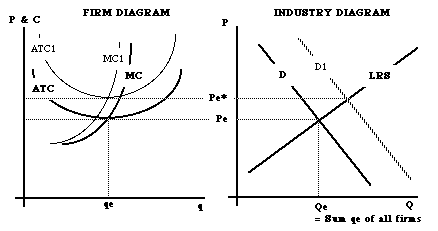 Now
suppose
that demand shifts right to D1. Initially, each existing firm
increases
output up its own MC curve, and makes pure profits. New firms are
attracted into the industry, increasing industry output and damping
down
the initial price increase. Increasing output increases the costs of
inputs
which shifts cost curves upwards to MC1 and ATC1. The new long
run
equilibrium results when firms are once again only making normal profit
(price Pe* = ATC1 = MC1), just covering all costs at their new
level.
Now
suppose
that demand shifts right to D1. Initially, each existing firm
increases
output up its own MC curve, and makes pure profits. New firms are
attracted into the industry, increasing industry output and damping
down
the initial price increase. Increasing output increases the costs of
inputs
which shifts cost curves upwards to MC1 and ATC1. The new long
run
equilibrium results when firms are once again only making normal profit
(price Pe* = ATC1 = MC1), just covering all costs at their new
level.
- The Industry long run supply curve (LRS) traces out the
increase
in output resulting from the shift in demand.
- Key Factors affecting the elasticity of supply
- It will always take time for the full supply response to a
demand
change
to materialise - long run elasticities more elastic than short run.
Over
and above this general condition:
- Flexibility of production systems and processes - the
more
flexible,
the more elastic supply;
- The more permanent the shift in demand is expected
to
be,
the more likely it is that firms will take long run decisions and that
new firms will become established - so the more elastic the
supply
response will be.
- The more industry or sector specific are the inputs and
resources
used, and the more limited they are in supply, the greater will
be the cost increase associated with industry expansion, and the less
elastic will be the industry supply response; (e.g. -
agriculture,
with the requirement for land, which is limited in total supply).
Imperfect Competition: the key difference
between perfect competition and imperfect competition
is
the nature of the demand facing the firm. -
- perfect competitors are Price Takers - cannot set or affect the
market
price on their own;
- imperfect competitors are Price Setters - they can set their own
prices,
and their sales levels affect the prices they can charge.
- Imperfect competitors face downward sloping demand curves,
rather
than the perfectly elastic (horizontal) demand curves which facce each
FIRM in perfect competition.
- So, for imperfect competition, Price DOES NOT equal Marginal
Revenue
(MR)
- the additional revenue earned by imperfect competitors from the sale
of an extra unit of production requires that the price charged for all
sales has also to be reduced - the Marginal Revenue curve is therefore steeper
(more inelastic) than the demand curve.
- For a linear demand curve, the MR curve will be twice as steep
as the
demand
curve (beginning at the same price on the vertical axis as the demand
curve,
but intersecting the horizontal (quantity) axis at half the quantity of
the demand curve
Monopolistic Competition: - differentiate their products
from those of their competitors (advertising, brand loyalty etc.), but
are vulnerable to competition from rival firms for market shares.
-
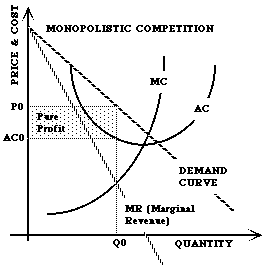 Profit
Maximising
means produce at quantity for which MR = MC.
Profit
Maximising
means produce at quantity for which MR = MC.
- Set price for this quantity (Q0) according to consumers
willingness to
pay (the demand curve price for this quantity - P0
- Cost of producing this quantity (Q0) is AC0 per unit, so profit =
(p0 -
AC0) x Q0; the shaded area.
- So, more firms will try and enter this industry
- with the effect that the demand curve and MR curve for this firm
will
SHIFT
to the left as new entrants take market share
- Equilibrium in this Monopolistic Competition sector will occur
when
there
are no pure profits left to attract new entrants
- No Pure Profits when, and only when, the Demand Curve shifts far
enough
to the left to lie at a TANGENT to the AC curve - then Price is set so
as to equal AC.
- At this production (sales) point, MC will also equal MR - profit
maximising
with no pure profits.

Pure Monopoly:
The same as Monopolistic Competition EXCEPT that new firms CANNOT enter
the market to errode this firms market share.
The first diagram above, from Monopolistic Competition applies to
Monopolists.
Reasons for Pure Monopoly - single supplier to whole market:
- Natural Monopoly: production and supply conditions such
that
there
is only room for one supplier from the whole market - costs are such
that
one firm can supply the total market more efficiently (lower costs)
than
a collection of firms (e.g. gas, electricity, railways etc.)
- Patent rights over technologies - giving single firm temporary
advantage
- Monopoly Property Rights over necessary raw materials
- Predatory business practices and artificial barriers to entry of
other
potential competitors
1 and 2 are probably justifiable reasons for a monopoly - 3 and 4 are
not,
and are typically outlawed, or at least restrained (by patent laws,
etc.).
But Monopolists do not always make pure profits because:
- Market is not large enough to allow monopolist to exploit cost
advantage
- railways in early days.
- Market shrinks because of substitutes (e.g. road and air for
rail) -
note:
existence of close substitutes will make demand facing monopolist more
elastic - bringing demand and MR curves closer together and reducing
scope
for pure profits.
- Costs increase (cost curves rise) because:
- suppliers and labour force also have more market power against
a single
user
- management performance falls through lack of competitive spur
to do
better
Natural Monopolies are sensible from an economic point of view - but
require
Regulation
by Government to ensure that consumers and users are not ripped
off.
Major Problems for Regulators:
- Control over monoplists costs - how to ensure efficient
production and
operation?
- Setting socially acceptable prices - how to set prices to users
so as
to
cover legitimate costs but not result in over-supply (costs higher than
willingness to pay)?
So: Competition ensures that
consumers and users benefit from the lowest prices possible (consistent
with producers earning sufficient incomes to persuade them to stay in
the business, and competition encourages firms (producers) to stay as
efficient as possible, encouraging innovation and adaptation in the
interests of increasing value and improving efficiency. Nevertheless,
it is an uncomfortable business environment, and we might expect
producers to try and protect their own markets if at all possible.
Back to Index